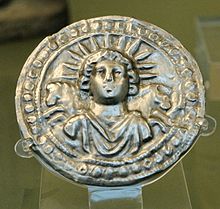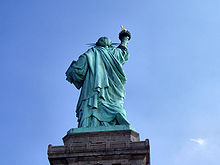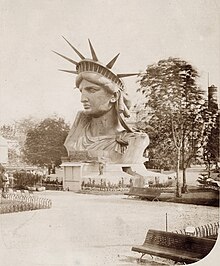Statue Of Liberty
Statue Of Liberty
The Statue of Liberty (Liberty Enlightening the World; French: La Liberté éclairant le monde) is a colossal neoclassical sculpture on Liberty Island in New York Harbor within New York City, in the United States. The copper statue, a gift from the people of France to the people of the United States, was designed by French sculptor Frédéric Auguste Bartholdi and its metal framework was built by Gustave Eiffel. The statue was dedicated on October 28, 1886.
The statue is a figure of Libertas, a robed Roman liberty goddess. She holds a torch above her head with her right hand, and in her left hand carries a tabula ansata inscribed JULY IV MDCCLXXVI (July 4, 1776 in Roman numerals), the date of the U.S. Declaration of Independence. A broken shackle and chain lie at her feet as she walks forward, commemorating the recent national abolition of slavery.[8] After its dedication, the statue became an icon of freedom and of the United States, seen as a symbol of welcome to immigrants arriving by sea.
Bartholdi was inspired by a French law professor and politician, Édouard René de Laboulaye, who is said to have commented in 1865 that any monument raised to U.S. independence would properly be a joint project of the French and U.S. peoples. The Franco-Prussian War delayed progress until 1875, when Laboulaye proposed that the French finance the statue and the U.S. provide the site and build the pedestal. Bartholdi completed the head and the torch-bearing arm before the statue was fully designed, and these pieces were exhibited for publicity at international expositions.
The torch-bearing arm was displayed at the Centennial Exposition in Philadelphia in 1876, and in Madison Square Park in Manhattan from 1876 to 1882. Fundraising proved difficult, especially for the Americans, and by 1885 work on the pedestal was threatened by lack of funds. Publisher Joseph Pulitzer, of the New York World, started a drive for donations to finish the project and attracted more than 120,000 contributors, most of whom gave less than a dollar. The statue was built in France, shipped overseas in crates, and assembled on the completed pedestal on what was then called Bedloe's Island. The statue's completion was marked by New York's first ticker-tape parade and a dedication ceremony presided over by President Grover Cleveland.
The statue was administered by the United States Lighthouse Board until 1901 and then by the Department of War; since 1933 it has been maintained by the National Park Service as part of the Statue of Liberty National Monument, and is a major tourist attraction. Public access to the balcony around the torch has been barred since 1916.
-----------------------------------------------------------------------------------------------------------------------------------------------
Design and construction process
Origin
According to the National Park Service, the idea of a monument presented by the French people to the United States was first proposed by Édouard René de Laboulaye, president of the French Anti-Slavery Society and a prominent and important political thinker of his time. The project is traced to a mid-1865 conversation between Laboulaye, a staunch abolitionist, and Frédéric Bartholdi, a sculptor. In after-dinner conversation at his home near Versailles, Laboulaye, an ardent supporter of the Union in the American Civil War, is supposed to have said: "If a monument should rise in the United States, as a memorial to their independence, I should think it only natural if it were built by united effort—a common work of both our nations."[9] The National Park Service, in a 2000 report, however, deemed this a legend traced to an 1885 fundraising pamphlet, and that the statue was most likely conceived in 1870.[10] In another essay on their website, the Park Service suggested that Laboulaye was minded to honor the Union victory and its consequences, "With the abolition of slavery and the Union's victory in the Civil War in 1865, Laboulaye's wishes of freedom and democracy were turning into a reality in the United States. In order to honor these achievements, Laboulaye proposed that a gift be built for the United States on behalf of France. Laboulaye hoped that by calling attention to the recent achievements of the United States, the French people would be inspired to call for their own democracy in the face of a repressive monarchy."[11]
According to sculptor Frédéric Auguste Bartholdi, who later recounted the story, Laboulaye's alleged comment was not intended as a proposal, but it inspired Bartholdi.[9] Given the repressive nature of the regime of Napoleon III, Bartholdi took no immediate action on the idea except to discuss it with Laboulaye. Bartholdi was in any event busy with other possible projects; in the late 1860s, he approached Isma'il Pasha, Khedive of Egypt, with a plan to build Progress or Egypt Carrying the Light to Asia,[12] a huge lighthouse in the form of an ancient Egyptian female fellah or peasant, robed and holding a torch aloft, at the northern entrance to the Suez Canal in Port Said. Sketches and models were made of the proposed work, though it was never erected. There was a classical precedent for the Suez proposal, the Colossus of Rhodes: an ancient bronze statue of the Greek god of the sun, Helios. This statue is believed to have been over 100 feet (30 m) high, and it similarly stood at a harbor entrance and carried a light to guide ships.[13] Both the khedive and Lesseps declined the proposed statue from Bartholdi, citing the expensive cost.[14] The Port Said Lighthouse was built instead, by François Coignet in 1869.
Any large project was further delayed by the Franco-Prussian War, in which Bartholdi served as a major of militia. In the war, Napoleon III was captured and deposed. Bartholdi's home province of Alsace was lost to the Prussians, and a more liberal republic was installed in France.[9] As Bartholdi had been planning a trip to the United States, he and Laboulaye decided the time was right to discuss the idea with influential Americans.[15] In June 1871, Bartholdi crossed the Atlantic, with letters of introduction signed by Laboulaye.[16]
Arriving at New York Harbor, Bartholdi focused on Bedloe's Island (now named Liberty Island) as a site for the statue, struck by the fact that vessels arriving in New York had to sail past it. He was delighted to learn that the island was owned by the United States government—it had been ceded by the New York State Legislature in 1800 for harbor defense. It was thus, as he put it in a letter to Laboulaye: "land common to all the states."[17] As well as meeting many influential New Yorkers, Bartholdi visited President Ulysses S. Grant, who assured him that it would not be difficult to obtain the site for the statue.[18] Bartholdi crossed the United States twice by rail, and met many Americans who he thought would be sympathetic to the project.[16] But he remained concerned that popular opinion on both sides of the Atlantic was insufficiently supportive of the proposal, and he and Laboulaye decided to wait before mounting a public campaign.[19]
Bartholdi had made a first model of his concept in 1870.[20] The son of a friend of Bartholdi's, U.S. artist John LaFarge, later maintained that Bartholdi made the first sketches for the statue during his U.S. visit at La Farge's Rhode Island studio. Bartholdi continued to develop the concept following his return to France.[20] He also worked on a number of sculptures designed to bolster French patriotism after the defeat by the Prussians. One of these was the Lion of Belfort, a monumental sculpture carved in sandstone below the fortress of Belfort, which during the war had resisted a Prussian siege for over three months. The defiant lion, 73 feet (22 m) long and half that in height, displays an emotional quality characteristic of Romanticism, which Bartholdi would later bring to the Statue of Liberty.[21]
-----------------------------------------------------------------------------------------------------------------------------------------------
Design, style, and symbolism
Bartholdi and Laboulaye considered how best to express the idea of American liberty.[22] In early American history, two female figures were frequently used as cultural symbols of the nation.[23] One of these symbols, the personified Columbia, was seen as an embodiment of the United States in the manner that Britannia was identified with the United Kingdom, and Marianne came to represent France. Columbia had supplanted the traditional European personification of the Americas as an "Indian princess", which had come to be regarded as uncivilized and derogatory toward Americans.[23] The other significant female icon in American culture was a representation of Liberty, derived from Libertas, the goddess of freedom widely worshipped in ancient Rome, especially among emancipated slaves. A Liberty figure adorned most American coins of the time,[22] and representations of Liberty appeared in popular and civic art, including Thomas Crawford's Statue of Freedom (1863) atop the dome of the United States Capitol Building.[22]
The statue's design evokes iconography evident in ancient history including the Egyptian goddess Isis, the ancient Greek deity of the same name, the Roman Columbia and the Christian iconography of the Virgin Mary.[24][25]
Artists of the 18th and 19th centuries striving to evoke republican ideals commonly used representations of Libertas as an allegorical symbol.[22] A figure of Liberty was also depicted on the Great Seal of France.[22] However, Bartholdi and Laboulaye avoided an image of revolutionary liberty such as that depicted in Eugène Delacroix's famed Liberty Leading the People (1830). In this painting, which commemorates France's July Revolution, a half-clothed Liberty leads an armed mob over the bodies of the fallen.[23] Laboulaye had no sympathy for revolution, and so Bartholdi's figure would be fully dressed in flowing robes.[23] Instead of the impression of violence in the Delacroix work, Bartholdi wished to give the statue a peaceful appearance and chose a torch, representing progress, for the figure to hold.[26]
Crawford's statue was designed in the early 1850s. It was originally to be crowned with a pileus, the cap given to emancipated slaves in ancient Rome. Secretary of War Jefferson Davis, a Southerner who would later serve as President of the Confederate States of America, was concerned that the pileus would be taken as an abolitionist symbol. He ordered that it be changed to a helmet.[27] Delacroix's figure wears a pileus,[23] and Bartholdi at first considered placing one on his figure as well. Instead, he used a diadem, or crown, to top its head.[28] In so doing, he avoided a reference to Marianne, who invariably wears a pileus.[29] The seven rays form a halo or aureole.[30] They evoke the sun, the seven seas, and the seven continents,[31] and represent another means, besides the torch, whereby Liberty enlightens the world.[26]
Bartholdi's early models were all similar in concept: a female figure in neoclassical style representing liberty, wearing a stola and pella (gown and cloak, common in depictions of Roman goddesses) and holding a torch aloft. According to popular accounts, the face was modeled after that of Charlotte Beysser Bartholdi, the sculptor's mother,[32] but Regis Huber, the curator of the Bartholdi Museum is on record as saying that this, as well as other similar speculations, have no basis in fact.[33] He designed the figure with a strong, uncomplicated silhouette, which would be set off well by its dramatic harbor placement and allow passengers on vessels entering New York Bay to experience a changing perspective on the statue as they proceeded toward Manhattan. He gave it bold classical contours and applied simplified modeling, reflecting the huge scale of the project and its solemn purpose.[26] Bartholdi wrote of his technique:
----------------------------------------------------------------------------------------------------------------------------------------------
Construction in France
On his return to Paris in 1877, Bartholdi concentrated on completing the head, which was exhibited at the 1878 Paris World's Fair. Fundraising continued, with models of the statue put on sale. Tickets to view the construction activity at the Gaget, Gauthier & Co. workshop were also offered.[55] The French government authorized a lottery; among the prizes were valuable silver plate and a terracotta model of the statue. By the end of 1879, about 250,000 francs had been raised.[56]
The head and arm had been built with assistance from Viollet-le-Duc, who fell ill in 1879. He soon died, leaving no indication of how he intended to transition from the copper skin to his proposed masonry pier.[57] The following year, Bartholdi was able to obtain the services of the innovative designer and builder Gustave Eiffel.[55] Eiffel and his structural engineer, Maurice Koechlin, decided to abandon the pier and instead build an iron truss tower. Eiffel opted not to use a completely rigid structure, which would force stresses to accumulate in the skin and lead eventually to cracking. A secondary skeleton was attached to the center pylon, then, to enable the statue to move slightly in the winds of New York Harbor and as the metal expanded on hot summer days, he loosely connected the support structure to the skin using flat iron bars[33] which culminated in a mesh of metal straps, known as "saddles", that were riveted to the skin, providing firm support. In a labor-intensive process, each saddle had to be crafted individually.[58][59] To prevent galvanic corrosion between the copper skin and the iron support structure, Eiffel insulated the skin with asbestos impregnated with shellac.[60]
Eiffel's design made the statue one of the earliest examples of curtain wall construction, in which the exterior of the structure is not load bearing, but is instead supported by an interior framework. He included two interior spiral staircases, to make it easier for visitors to reach the observation point in the crown.[61] Access to an observation platform surrounding the torch was also provided, but the narrowness of the arm allowed for only a single ladder, 40 feet (12 m) long.[62] As the pylon tower arose, Eiffel and Bartholdi coordinated their work carefully so that completed segments of skin would fit exactly on the support structure.[63] The components of the pylon tower were built in the Eiffel factory in the nearby Parisian suburb of Levallois-Perret.[64]
The change in structural material from masonry to iron allowed Bartholdi to change his plans for the statue's assembly. He had originally expected to assemble the skin on-site as the masonry pier was built; instead, he decided to build the statue in France and have it disassembled and transported to the United States for reassembly in place on Bedloe's Island.[65]
In a symbolic act, the first rivet placed into the skin, fixing a copper plate onto the statue's big toe, was driven by United States Ambassador to France Levi P. Morton.[66] The skin was not, however, crafted in exact sequence from low to high; work proceeded on a number of segments simultaneously in a manner often confusing to visitors.[67] Some work was performed by contractors—one of the fingers was made to Bartholdi's exacting specifications by a coppersmith in the southern French town of Montauban.[68] By 1882, the statue was complete up to the waist, an event Barthodi celebrated by inviting reporters to lunch on a platform built within the statue.[69] Laboulaye died in 1883. He was succeeded as chairman of the French committee by Ferdinand de Lesseps, builder of the Suez Canal. The completed statue was formally presented to Ambassador Morton at a ceremony in Paris on July 4, 1884, and de Lesseps announced that the French government had agreed to pay for its transport to New York.[70] The statue remained intact in Paris pending sufficient progress on the pedestal; by January 1885, this had occurred and the statue was disassembled and crated for its ocean voyage.[71]
The committees in the United States faced great difficulties in obtaining funds for the construction of the pedestal. The Panic of 1873 had led to an economic depression that persisted through much of the decade. The Liberty statue project was not the only such undertaking that had difficulty raising money: construction of the obelisk later known as the Washington Monument sometimes stalled for years; it would ultimately take over three-and-a-half decades to complete.[72] There was criticism both of Bartholdi's statue and of the fact that the gift required Americans to foot the bill for the pedestal. In the years following the Civil War, most Americans preferred realistic artworks depicting heroes and events from the nation's history, rather than allegorical works like the Liberty statue.[72] There was also a feeling that Americans should design American public works—the selection of Italian-born Constantino Brumidi to decorate the Capitol had provoked intense criticism, even though he was a naturalized U.S. citizen.[73] Harper's Weekly declared its wish that "M. Bartholdi and our French cousins had 'gone the whole figure' while they were about it, and given us statue and pedestal at once."[74] The New York Times stated that "no true patriot can countenance any such expenditures for bronze females in the present state of our finances."[75] Faced with these criticisms, the American committees took little action for several years.[75]
-----------------------------------------------------------------------------------------------------------------------------------------------








Hello everyone I am the youtuber and also a blogger. Please comment me.
ReplyDelete